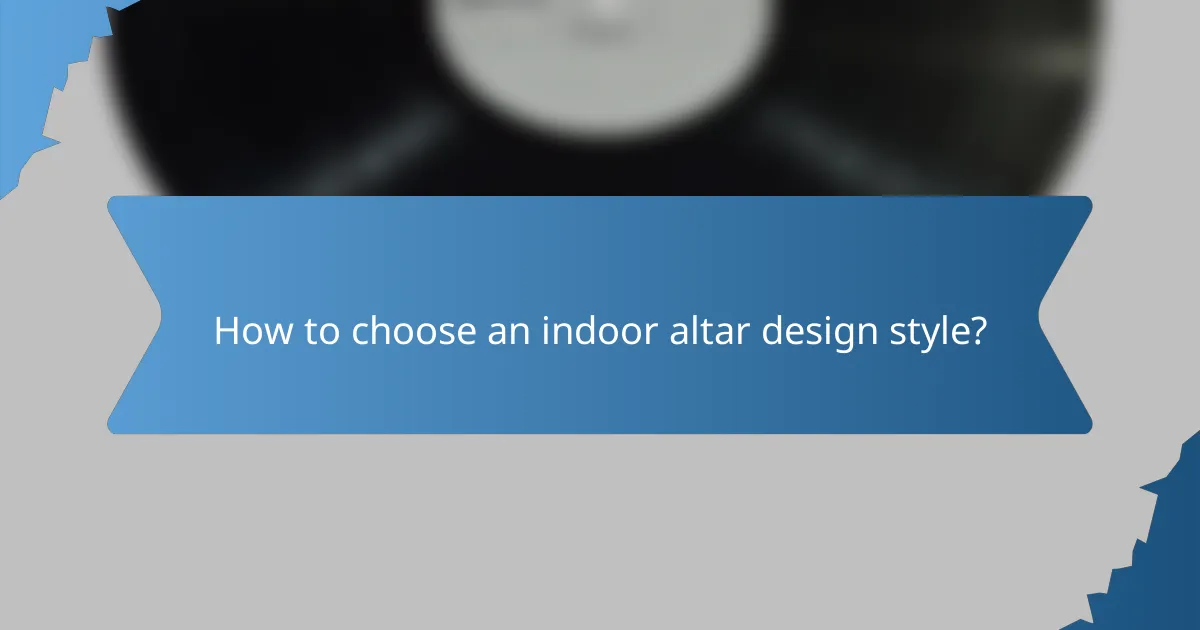Designing an indoor altar requires careful consideration of space, layout, and lighting to create a functional and inviting environment. The costs associated with decorating the altar can range significantly, depending on the materials and aesthetics chosen. Additionally, incorporating elements that enhance ambiance, such as natural elements and sound, is essential for fostering a serene atmosphere.

What space considerations are important for an indoor altar?
When creating an indoor altar, key space considerations include size, layout, accessibility, and lighting. Each aspect plays a crucial role in ensuring the altar is functional, inviting, and conducive to the intended ambiance.
Size and layout
The size of your altar should reflect the available space in your home while accommodating the items you wish to display. A small altar can be as simple as a shelf or table, while larger spaces may allow for more elaborate setups with multiple layers or sections.
Consider the layout to ensure a harmonious arrangement. Items such as candles, statues, and offerings should be organized in a way that promotes balance and ease of use. A common approach is to create a triangular formation, which can enhance visual appeal and accessibility.
Accessibility and flow
Accessibility is vital for an indoor altar, as it should be easy to approach and interact with. Ensure that there is enough space around the altar for movement, allowing you to light candles or make offerings without obstruction.
Flow refers to how the altar fits within the overall space of the room. Position the altar in a way that encourages a natural path for movement, avoiding clutter that could disrupt the peaceful atmosphere. Consider placing it in a corner or against a wall to create a dedicated area without overwhelming the room.
Lighting and location
Lighting significantly impacts the ambiance of your indoor altar. Natural light can enhance the space during the day, while soft artificial lighting can create a serene atmosphere in the evening. Consider using adjustable lighting options, such as dimmable lamps or candles, to set the desired mood.
Location is equally important; choose a spot that feels spiritually significant to you. This could be a quiet corner of a room or a dedicated space in a larger area. Ensure that the location allows for privacy and reflection, contributing to a tranquil environment for meditation or prayer.

What are the decorative costs for an indoor altar?
The decorative costs for an indoor altar can vary widely based on materials, design, and personal preferences. Budget-conscious individuals may spend a few dozen dollars, while those seeking high-end aesthetics could invest several hundred or even thousands of dollars.
Budget-friendly options
For those on a tight budget, creating an indoor altar can be achieved with minimal expenses. Simple items like candles, small plants, and handmade decorations can be sourced for under $50. Thrift stores and online marketplaces often have affordable options that can be personalized.
Consider using natural elements such as stones or wood from your surroundings, which can add a personal touch without additional costs. DIY projects can also enhance the altar’s appearance while keeping expenses low.
Mid-range decorative choices
Mid-range altar decorations typically range from $50 to $200. This budget allows for more variety and quality in materials, such as decorative fabrics, ceramic items, or framed art. Investing in a few key pieces can elevate the overall ambiance.
Look for items like handcrafted bowls, quality candles, or unique sculptures that resonate with your spiritual practice. Shopping at local artisan markets can yield beautiful finds that support local craftspeople.
High-end altar decorations
High-end altar decorations can cost anywhere from $200 to several thousand dollars, depending on the intricacy and craftsmanship of the items. This category includes custom-made pieces, luxury materials, and designer brands.
Consider investing in high-quality altar cloths, intricate statues, or bespoke artwork that reflects your spiritual journey. While these items can be costly, they often provide a lasting impact and can be seen as a long-term investment in your sacred space.

How can ambiance be created for an indoor altar?
Creating ambiance for an indoor altar involves using elements that promote a serene and reflective atmosphere. Key components include lighting, natural elements, and sound, all of which contribute to the overall experience of the space.
Use of candles and incense
Candles and incense are essential for setting a calming mood at an indoor altar. The flickering light of candles can create a warm, inviting glow, while incense adds aromatic depth, enhancing the sensory experience.
Consider using unscented candles for a subtle ambiance or scented varieties that align with your intentions, such as lavender for relaxation or sandalwood for grounding. Ensure proper ventilation when burning incense to avoid overwhelming the space.
Incorporating plants and natural elements
Integrating plants and natural materials into your altar can foster a connection to nature, promoting tranquility. Choose low-maintenance plants like succulents or peace lilies, which thrive indoors and require minimal care.
In addition to plants, consider using stones, crystals, or wood to enhance the altar’s aesthetic. These elements can symbolize various intentions or energies, adding personal significance to your space.
Sound and music considerations
Sound plays a crucial role in creating ambiance for an indoor altar. Soft background music or nature sounds can enhance relaxation and focus during meditation or prayer. Choose calming genres like ambient, classical, or instrumental music to maintain a peaceful atmosphere.
Be mindful of volume levels; sounds should be soothing and not distracting. You might also consider using singing bowls or chimes for a more interactive auditory experience, allowing you to engage with the space on a deeper level.

What materials are best for indoor altar construction?
For indoor altar construction, wood and metal are the most common materials, each offering unique aesthetic and functional benefits. The choice between them depends on your design preferences, budget, and the intended use of the altar.
Wood vs. metal options
Wood is often favored for its warmth and natural beauty, making it suitable for a serene and inviting atmosphere. Common choices include oak, pine, and cedar, which can range in price from moderate to high depending on quality and finish.
Metal, such as stainless steel or wrought iron, provides a modern and durable alternative. While typically more expensive, metal can withstand wear and tear better than wood, making it ideal for high-traffic areas or outdoor use.
Durability and maintenance
Wood requires regular maintenance, including polishing and occasional refinishing to prevent damage from moisture and pests. Depending on the type of wood, maintenance costs can vary, but budgeting for periodic upkeep is essential.
Metal, on the other hand, is generally more resilient and easier to clean. It can resist rust and corrosion, especially if treated properly. However, it may require occasional checks for scratches or dents, particularly in high-use environments.

How to choose an indoor altar design style?
Selecting an indoor altar design style involves considering your personal preferences, the space available, and the overall ambiance you wish to create. Focus on aesthetics that resonate with you while ensuring the altar complements your home environment.
Traditional vs. modern aesthetics
Traditional altar designs often feature ornate details, rich materials, and cultural symbols, creating a sense of history and reverence. In contrast, modern aesthetics lean towards minimalism, clean lines, and functional materials, promoting a serene and uncluttered space.
When choosing between traditional and modern styles, consider the existing decor of your home. A traditional altar may suit a classic interior, while a modern altar can enhance contemporary spaces. Both styles can be adapted to fit various budgets, from simple DIY projects to more elaborate installations.
Personalization and cultural influences
Personalization is key in altar design, allowing you to reflect your beliefs and cultural background. Incorporating elements like family heirlooms, symbols of faith, or culturally significant artifacts can make your altar uniquely yours.
Consider the cultural influences that resonate with you. For example, a Buddhist altar might include a statue of Buddha and incense holders, while a Christian altar may feature a cross and candles. Tailoring your altar to your cultural identity not only enhances its significance but also enriches the overall ambiance of your space.

What trends are emerging in indoor altar design?
Emerging trends in indoor altar design focus on sustainability, minimalism, and seamless integration with home decor. These trends reflect a growing desire for personal expression while maintaining harmony within living spaces.
Sustainable materials
Sustainable materials are increasingly favored in indoor altar design, emphasizing eco-friendliness and ethical sourcing. Common choices include reclaimed wood, bamboo, and natural stone, which not only reduce environmental impact but also add unique character to the altar.
When selecting materials, consider durability and maintenance. For instance, bamboo is lightweight and resistant to moisture, making it ideal for indoor settings. Aim for a balance between aesthetics and sustainability, ensuring that your altar reflects your values.
Minimalist approaches
Minimalist approaches in altar design prioritize simplicity and functionality, allowing for a serene atmosphere. This trend often involves clean lines, neutral colors, and a limited number of decorative elements, which can help create a peaceful space for reflection.
To achieve a minimalist altar, focus on essential items that hold personal significance. Limit decorative pieces to a few meaningful objects, such as candles or crystals, and choose a simple altar table that complements your home’s style without overwhelming the space.
Integration with home decor
Integrating an indoor altar with home decor enhances both the altar’s presence and the overall aesthetic of the room. This can be achieved by selecting colors and materials that match existing furnishings, creating a cohesive look that feels intentional.
Consider placing the altar in a prominent yet harmonious location, such as a corner of the living room or a dedicated nook. Use decorative elements like plants or artwork that resonate with the altar’s theme, ensuring it complements rather than clashes with your home’s design.
